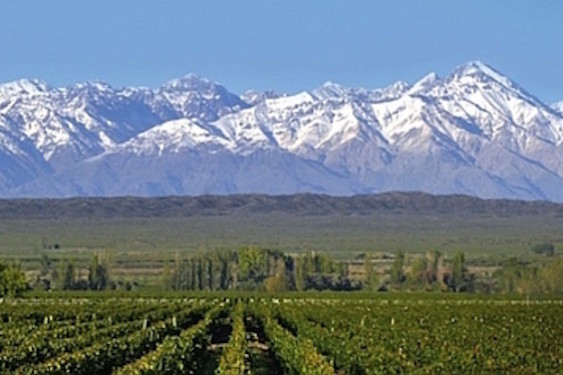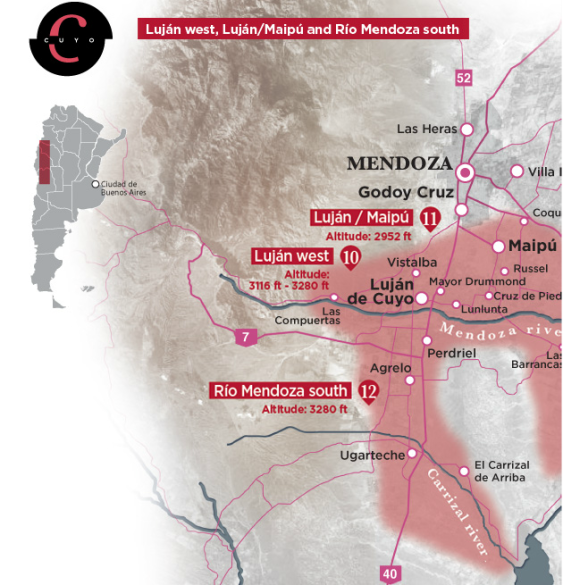As the grape harvest approaches in the Southern Hemsiphere, I’ve been talking a lot about Australia. But today, let’s cross the Pacific (and the Andes) to one of the world’s other major wine-producing countries, Argentina, where they’ll also be picking the grapes soon.
The first vines were planted in Argentina in 1551 by Catholic missionaries who needed to produce wine to celebrate communion during the Holy Mass. But it wasn’t until an influx of European immigrants in the 19th century that the wine industry really took off. These immigrants, many of whom came from Italy and Germany, introduced new techniques for growing vines. They also brought new grape varieties with them, including Malbec, which originates in the southwest of France, but by now is synonymous with the Argentine wine industry.

Malbec has become synonymous with Argentine wine.
By the early 20th century, the country had over half a million acres under vine, and today, there are over 1,200 wineries in the country. All that’s to say, Argentines know how to make good wine.
The largest and most famous wine region in Argentina, and the one you are likely to have come across (if not visited yourself) is Mendoza. It produces about 80% of the wine in Argentina, and surrounds the major city of the same name at the base of the Argentine Andes (it’s actually closer to Santiago than to Buenos Aires). But that belies just how large and diverse the region actually is.

Mendoza is Argentina’s largest and most famous wine region.
Some of the things that distinguish Mendoza from other wine regions both in Argentina and around the world are that its vineyards lie, for the most part, between 2,000-3,500 feet above sea level. This is also a relatively dry area, technically a desert, with under 10 inches of rainfall per year, though vineyards are irrigated from rivers and the melting snowpack of the Andes.
In fact, Mendoza consists of about nine major sub-regions that can then be further sub-divided to very specific areas. We’ll get to some of those in future posts, but in the meantime, here are six of the most important, and what they are known for. But if you’re tight on brain space and shopping time, just look for wines from the first three.

Luján de Cuyo and Maipu are the two sub-regions closest to Mendoza.
Luján de Cuyo: This is the region closest to the city of Mendoza itself, and was the first official wine appellation in Argentina. By some accounts, Malbec has been grown here since the 1860s. Luján de Cuyo is one of the coolest regions around Mendoza, temperature-wise, and there is a huge range of altitude here, as well as interesting soils thanks to the fact that the Mendoza River runs through it. The Malbecs tend to be concentrated and fruit-dominant, but with a nice balance of acidity to keep them from becoming overpowering. Among the wineries to visit (or try) in these parts are Norton, Catena Zapata and Viña Cobos.
Maipu: Southeast of Mendoza city, Maipu is also close to Luján de Cuyo, but the wines made here can be quite different thanks to more consistent altitudes and sandier soils. The Malbecs from here are very structured and concentrated with deep purple hues and wild berry flavors. Some of the wineries with vineyards here you might know include Familia Zuccardi, Rutini and Trapiche.

The Uco Valley is the upstart foreign investors are excited about.
Uco Valley: About two hours southwest of the city, nestled right into the foothills of the Andes, is both the largest and newest sub-region of Mendoza, the Uco Valley. In fact, it’s so large that it includes three departments within the Mendoza province: Tupungato, Tunuyan and San Carlos. The vineyards here are closer to the mountains, so there is more temperature range each day and a greater variety of soil types. The grapes also tend to take a little longer to ripen. All that leads to more intensity, complexity and nuance in the wines, especially Malbecs, and an acid structure that lends itself well to aging. No wonder there has been so much foreign investment here of late. The big players are Salentein, O. Fournier and Clos de los Siete, which is a major project that represents a consortium of seven French-owned wineries.

There’s more to Mendoza than just red wine, too!
If you’ve got all that down, here are three more sub-regions to keep in mind, though you might not see as many of their wines in the US.
Eastern Mendoza: One of the older wine-producing zones of Mendoza and still a major area for production, wines made here tend to be fruity, light-bodied and with low acidity and so are intended for bulk production and table wines.
Northern Mendoza: This is more of a white wine area, so if you find a Torrontes from Mendoza, chances are it was grown around here.
Southern Mendoza: The two major sub-zones around these parts, about 120 miles south of Mendoza city, are San Rafael and General Alvear. This area is also known for white wines, but you’ll also find red varieties like Cabernet Sauvignon and Pinot Noir. Wines are mostly bulk productions for domestic consumption.
Have a favorite Mendoza Malbec of your own? Tweet me about it @clustercrush!

